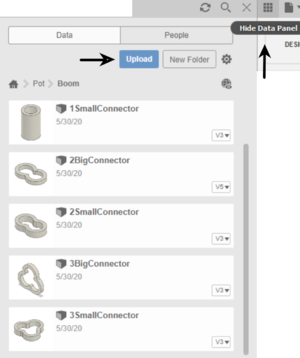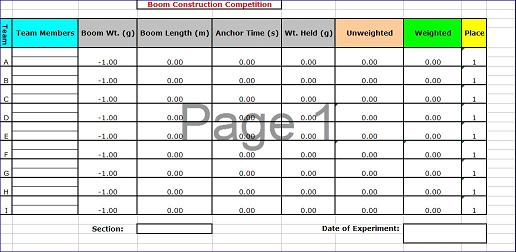Difference between revisions of "Boom Construction Competition"
| Line 142: | Line 142: | ||
<center><math>Design\ Ratio = \frac{Weight\ Supported}{Boom\ Weight} \times \frac{60\left[\text{s}\right]}{Anchor\ Time\left[\text{s}\right]+30\left[\text{s}\right]} \times \frac{Boom\ Length\left[\text{m}\right]}{1.5\left[\text{m}\right]}\,</math></center> | <center><math>Design\ Ratio = \frac{Weight\ Supported}{Boom\ Weight} \times \frac{60\left[\text{s}\right]}{Anchor\ Time\left[\text{s}\right]+30\left[\text{s}\right]} \times \frac{Boom\ Length\left[\text{m}\right]}{1.5\left[\text{m}\right]}\,</math></center> | ||
<p style="text-align:right">(4)</p> | <p style="text-align:right">(4)</p> | ||
=Materials and Equipment= | =Materials and Equipment= | ||
Revision as of 23:16, 4 September 2021
Objective
The experimental objective of this lab is to design and assemble a boom. This is a competition lab, and the booms will be judged by a design ratio that uses boom weight, boom length, weight held, and anchor time. The highest design ratio wins the competition.
Overview
A boom is used to lift and move heavy objects, often objects that are much heavier than the boom itself. Distributing the load being lifted over the length of the boom is the main problem in boom design. The design must consider the maximum load the boom will be required to lift, how high the load will be lifted, and whether the boom will be moved or remain stationary while loaded.
Examples of Booms
Certain types of bridges use booms. A cantilever bridge uses two booms extending from a common base. One type of cantilever bridge is a cable-stayed bridge (Figure 1).
The Ed Koch Queensboro Bridge is a double cantilever bridge (Figure 2). It has two bases with two booms extending from each base and the cantilevers placed end to end.
The Grand Bridge over Newtown Creek is a swing bridge, also known as a rotating bridge (Figure 3). This bridge has two booms mounted on a base that rotates.
Figure 4 shows a bascule bridge, more commonly known as a drawbridge, where it is clear that the bridge uses a big, very flat boom.
Not all bridges are booms. Suspension bridges use a deck that is supported by steel cables, not booms. Examples of suspension bridges are the Brooklyn Bridge, Manhattan Bridge, Verrazano-Narrows Bridge, and the George Washington Bridge.
Cranes are the most common example of booms. The crane pictured in Figure 5 is a tower crane. These cranes are a fixture on construction sites around the world. A tower crane can lift a 40,000 lb load. It is attached to the ground by anchor bolts driven through a 400,000 lb concrete pad poured a few weeks before the crane is erected (Howstuffworks.com, 2003).
Stress and Strain
The design of a boom must consider the properties of the materials used to build the boom. The mechanical properties and deformation of solids are explained by stress and strain. When an external force is applied to a material, it changes shape (e.g. changes length and cross-section perpendicular to the length). Understanding how deformation will affect materials is a critical consideration in boom design.
According to Serway and Beichner in “Physics for Scientists and Engineers,” stress is the external force acting on an object per unit cross sectional area. Strain is the measure of deformation resulting from an applied stress (Figure 6).
The expression (1) for tensile stress shows the relationship between an applied force and the cross-sectional area.
(1)
In (1), σ is the stress, F is the applied force, and A is the cross-sectional area of the object perpendicular to the force. The resulting strain (2) is calculated by dividing the change in length of the object by the original length.
(2)
In (2), ΔL is the change in length and L0 is the object's original length.
There are three basic types of stresses; tensile (pulling or stretching), compressive (squeezing or squashing), and shear (bending or cleaving). Consider a straight metal beam. If a tensile stress is applied to both ends, its length will increase in both directions of the force, while its cross-sectional area perpendicular to the force applied will decrease. Under compressive stress, the opposite will occur. If the beam is subjected to shear stress, it will bend towards the direction of the applied force, and both the length and cross-sectional area of the beam will become distorted. Figure 7 depicts a graphic representation of the three common forms of stress.
Strain is proportional to stress for material dependent values of strain. If the material is known, it is possible to derive strain from measured stress, and vice-versa, up to a certain level of stress. This unitless mathematical constant is referred to as the elastic modulus, or Young’s modulus. The moduli of different materials is an important factor to consider when designing or building any form of structure that will be under stresses.
Stress-Strain Curve
A stress-strain graphically shows the relationship between the stress and strain of a material under load. Figure 8 shows the stress-strain curve of a common metallic building material. In the elastic region, the material will regain its original shape once the stress is removed. The elastic region in Figure 8 is fairly linear. The slope of this linear portion of the stress-strain curve is the elastic modulus.
The elastic limit for a material is the maximum strain it can sustain before it becomes permanently deformed (i.e. if the stress is decreased, the object no longer returns to its original size and shape). In the plastic region, the material loses its elasticity and is permanently deformed. A linear approximation with the elastic modulus is no longer accurate.
The ultimate tensile strength is the maximum stress a material can undergo. The fracture stress is the point at which the material breaks. Fracture stress is lower than the ultimate tensile strength of a material because the material has reached that level of stress and has already begun to fail. The cross-sectional area is constantly decreasing until the material finally breaks.
In addition to these intrinsic materials factors, the behavior of materials as they age and are used in service must be considered in boom design. These factors are not applicable to the boom design in this lab, but they must be considered when deciding what material to use for a design. The loss of desirable properties through use, called fatigue, is important. Non-static loads, repeated loading and unloading, or loads that include vibrations or oscillations will eventually lead to failure in service. Special care must be taken with live loads and situations where small motions may be magnified by design features.
There are many factors to consider in any design project. When designing and constructing the boom for this competition, consider the materials being used and what might cause those materials to fail under a load.
Competition Rules
The competition rules must be followed at all times during the competition. Violation of any of these rules will result in the disqualification of the design.
- The boom is to be secured (i.e. anchored) to the white plastic anchorage provided at the front of the lab
- The boom must extend at least 1.5 meters horizontally from the front edge of the anchorage
- The boom must be anchored in two minutes or less
- The boom may not touch anything but the anchorage
- The basic weight ratio (3) for the competition uses the weight supported divided by the boom weight
- The winning design will be determined by the weighted design ratio (4), which uses the weight ratio, anchor time, and boom length
(3)
(4)
Materials and Equipment
- Two thick dowels (1.1 cm × 122 cm)
- Two thin dowels (0.8 cm × 122 cm)
- Six bamboo skewers (30.5 cm)
- 3D printed dowel connectors
- Cellophane tape
- Kevlar string
- Fusion 360 (Remote students)
Note: A saw is available to cut the dowels. Ask a TA for assistance, as only TAs may use the saw.
Procedure
Note for Hybrid Session
In-person students are expected to complete the competition part of the procedure, indicated by the label (In-Person). Remote students are expected to complete the virtual boom analysis part of the procedure, indicated by the label (Remote). Any procedure labeled (Hybrid) is expected to be completed through a joint collaboration between remote and in-person students.
1. Boom Design and Construction (Hybrid)
- Assess the materials and consider the design options, keeping in mind the competition specifications. Preliminary sketches must be completed during this process
- Sketch the basic design in pencil using the lab notes paper provided by a TA or on the EG1003 website. Label the design clearly and discuss the pros and cons of the design with your teammates.
- Construct the boom based on the completed sketch and the available materials. A TA will provide the materials allowed for the design. If the design is modified during the construction phase, make sure to note the changes and describe the reasons for them.
- While in-person students begin to construct the boom, remote students will analyze a sample boom simulation on Fusion 360 to gain a better understanding of the forces that will affect the boom. After viewing the simulation, remote students will then move to construct their groups boom design in Fusion 360. This is highlighted in the section below.
- After the virtual students have completed the Virtual Boom Analysis procedure, and in-person students have completed step 3 of this procedure, ask a TA to begin load testing for your in-person boom.
- A TA will weigh the boom and record the weight in the competition spreadsheet for the section.
2. Virtual Boom Analysis (Remote)
The steps below will go through how to analyze and understand the boom simulation, and find the corresponding design ratio for it. The boom simulation was made using the parts with the same shape of the in-person boom parts, and an assumed material with the approximate inputted properties of wood was used (Research isotropic vs orthotropic materials). The data needed for the design ratio will be found and translated and the forces along the boom will be analyzed to improve the in-person boom design.
- The example of the boom model can be found in a ZIP folder here. The latest version of Fusion 360 must be downloaded for the parts to appear properly.
- Unzip the parts to a space on the computer.
- In Fusion 360, open the Data Panel (icon with 9 boxes at the top left) and click Upload. Select the unzipped part files to upload them to Fusion 360’s cloud memory. Fusion 360 can only import files uploaded to its cloud.
- Ensure that the Design workspace is open in Fusion 360. This is indicated at the top left.
- Double click on the Theoretical Boom file in the Data Panel to open it.
Mass of the Boom
- Ensure that the Design workspace is open in Fusion 360. This is indicated at the top left.
- Go to the Browser on the left-hand side of the workspace. Use the small, white arrows on the left of the part names to open their folders. Open the Bodies folder of the part, right click the body of interest, and select Properties (Figure 14).
- In the Properties dialog that appears, record the mass of the body.
- Repeat these steps for all the bodies in the boom design and add the masses to obtain the total mass of the boom. Record the total mass of the boom in your Lab Notes.
Length of the Boom
- Ensure that the Design workspace is open in Fusion 360. This is indicated at the top left.
- In the toolbar, go to Inspect > Measure.
- In a side view of the boom, select a point at the front of the anchor and then another point at the tip of the boom.
- In the Measure dialog, check the XYZ Delta box.
- From the Measure dialog, record the length in meters in your Lab Notes.
Understanding the Results
- Switch the workspace from Design to Simulation at the top left of the screen. Note: If you get an interference warning it can be ignored since seeing the contacts allows better visualization of the boom’s deflection.
- The results will now be calculated and obtained. In the Browser tab, right click Results > Solve. In the Solve dialog, click Solve 1 Study. Wait for the simulation to complete.
- After the simulation has been solved, the workspace will show a deflected boom similar to the one shown below in Figure 16.
- The scale on the right will be reading Safety Factor with a scale from 0-15. Make sure the minimum safety factor is above 1. The safety factor is the yield strength of the material divided by the maximum stress calculated at a point. If this is under 1, this is the simulation showing a broken part.
- Use the drop down menu of the other options, for example the drop down menu for Reaction Force (figure 16), to analyze the boom further. Simulation contacts describe the interaction between parts in an assembly. Take a look at where the contact force is and use this knowledge for the analysis of your team's boom. This simulation is being displaced 20 cm, just like your boom will be, so the general reactions should be relevant to the actual boom that will be built by the in-person students.
Finding the Reaction Force
- The reaction force will be determined. In the Results toolbar, go to Inspect > Reactions and click the bottom face of the boom anchor as the Entity. By Newton's Second Law, the static displaced structure should have a reaction force on the fixed face equal to an imaginary weight placed when the beam was deflected. There is a force on the bottom face of the boom anchor that is a resultant of the 20 cm displacement at the end of the boom. This is the reaction force.
- From the Reactions dialog, record the axial force on the same axis that the displacement was directed on (Figure 17). It should be the largest of the three axial forces.
- Using the Reaction Force found, calculate the weight supported (5) as well as the basic weight ratio (3) and weighted design ratio (4) for the given virtual boom. This is done by following the math below derived from Newton’s Second Law. Assume Anchor time as 30 seconds.
(5)
- Use the knowledge gained from the simulation to edit the boom designed in Part 1. Record any changes to the design
3. Virtual Boom Construction in Fusion 360 (remote)
Note: Fusion 360, like all software, can take time to learn for new users. Reach out to a TA for any help and clarification needed. Some useful tools and functions are given in the Overview section but learn Fusion 360’s panels and functions beforehand.
Importing Parts
- The parts for the boom can be found in a ZIP folder here. The latest version of Fusion 360 must be downloaded for the parts to appear properly.
- Unzip the parts to a space on the computer.
- In Fusion 360, open the Data Panel (icon with 9 boxes at the top left) and click Upload. Select the unzipped part files to upload them to Fusion 360’s cloud memory (Figure 18). Fusion 360 can only import files uploaded to its cloud.
Model the Boom
- Ensure that the Design workspace is open in Fusion 360. This is indicated at the top left.
- The part files can be inserted into a new Fusion 360 file by simply dragging and dropping them from the Data Panel into the space. Alternatively, right click the components and select Insert into Current Design (Figure 19). Save the blank file before assembling the boom by going to File > Save as.
- The first part that is inserted into Fusion 360 acts as the base for the entire model. The boom anchor should be inserted first as the boom should be designed around it.
- Import the other parts based on the design that was sketched. Connect all the parts using the Align tool to complete the model. Use the tips from the Fusion 360 section in the Overview.
- Take time to get comfortable with moving each part around. Keep in mind that Fusion 360 is a 3D workspace and depth is not shown on a 2D screen, so use the orthographic cube at the top right of the workspace to change the view and ensure the components fit together.
- A short video is provided for reference here.
4. Competition (In-Person)
Note: Attaching the boom to the anchorage is a critical phase of the competition. Anchoring will be timed. Making sure there is a plan to anchor the boom quickly will improve its standing in the competition. Practice anchoring before the trial begins. The boom will be disqualified if anchoring the boom takes more than two minutes.
- When the TA says "go," attach the boom to the anchorage and shout "done" when the boom is anchored. The TA will only stop the timer once there are no more hands touching the boom. The TA will give the anchoring time. This value will be used to compute the boom's design ratio.
- A TA will measure the boom and record the length in the competition spreadsheet for the section
- A TA will attach a basket to the end of the boom and add weights until the boom deflects (bends) 0.2 m vertically. The load supported will be weighed on the lab scale and recorded in the competition spreadsheet for the section (Figure 120)
- The design ratio for the in-person boom design will be used to decide the winner of the competition.
A TA has prepared an Excel file with the section's results. It can be accessed in the Lab Documents section of the EG1003 website. This chart must be included in the PowerPoint presentation and in the Data/Observations section of the lab report. The lab work is now complete. Please clean up the workstation. Return all unused materials to a TA. Refer to the Assignment section for the instructions to prepare the lab report.
Assignment
Individual Lab Report
Follow the lab report guidelines laid out in the EG1004 Writing Style Guide in the Technical Writing section of the manual. Use the outline below to write this report.
- Describe the rules of the competition in the Introduction. What consequences did the rules have for any design decisions? Use the appropriate equations in the answer.
- What factors were considered in designing the boom? Was any of the background information used?
- What was the basic weight ratio and design ratio for the design?
- Describe how the components chosen functioned in the design, and describe its height/length/shape
- Describe the advantages and disadvantages of the boom design
- Discuss design improvements. How can the design be optimized (i.e. improve the ratio) based on experience?
- Which elements of the boom were stressed by the load, in what directions, and contributed to the failure?
- How can theoretical models help to predict experimental models?
- Does the simulation tell us everything about the system? If not, what sources of error are important to mention?
- Include the spreadsheet with every boom's results. Describe the results and talk about other designs in the class.
Remember: Lab notes must be taken. Experimental details are easily forgotten unless written down. EG1004 Lab Notes paper can be downloaded and printed from the EG1004 Website. Use the lab notes to write the Procedure section of the lab report. At the end of each lab, a TA will scan the lab notes and upload them to the Lab Documents section of the EG1004 Website. One point of extra credit is awarded if the lab notes are attached at the end of the lab report. Keeping careful notes is an essential component of all scientific practice.
Team PowerPoint Presentation
Follow the presentation guidelines laid out in the EG1004 Lab Presentation Format in the Technical Presentations section of the manual. When preparing the presentation, consider the following points.
- How can the boom design be improved?
- Other than the examples given in this lab, what are other examples of booms?
- Which elements of the boom (e.g., wooden dowels, 3D printed dowel connectors, Kevlar string, etc.,) were stressed by the load, in what directions, and contributed to the failure?
References
How Stuff Works website. 2003. SHW Media Network. Retrieved July 28, 2003. http://science.howstuffworks.com/tower-crane3.htm
Jennings, James. 2015. “Up, UP in a Crane: What Life is Like as a Tower Crane Operator.” Philadelphia. Accessed 14 January 2020 from www.phillymag.com
Serway, R., Beichner, R., Physics for Scientists and Engineers with Modern Physics, 5th Edition. Fort Worth, TX: Saunders College Publishing, 2000
| ||||||||
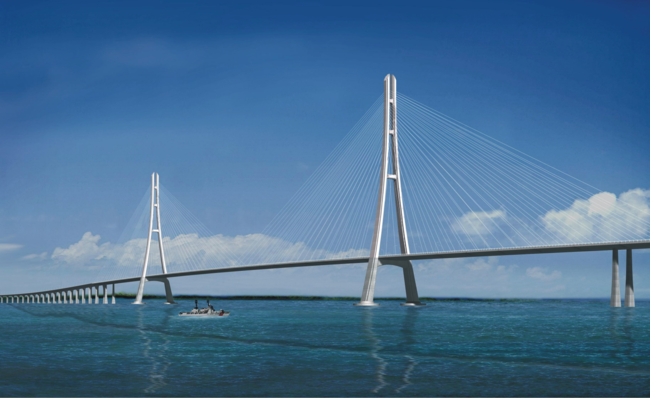


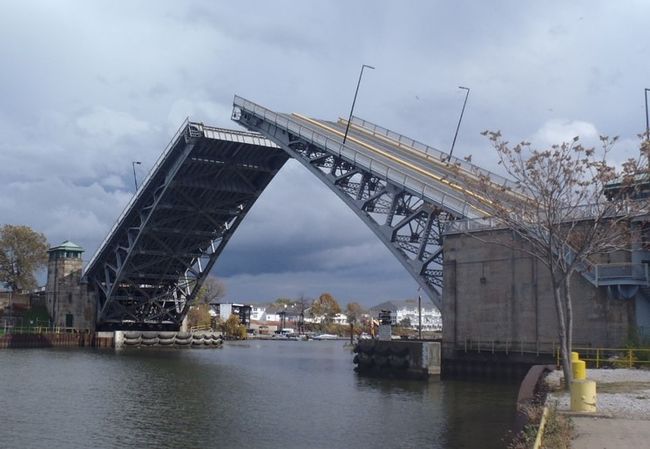
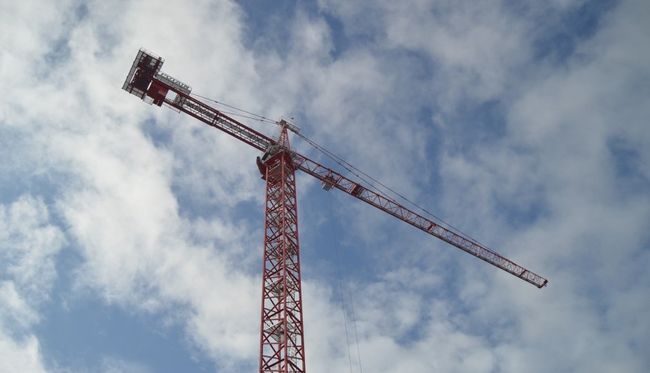
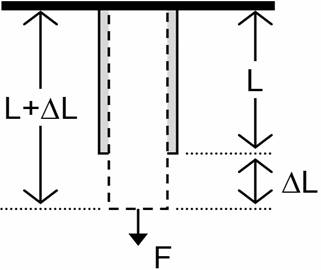


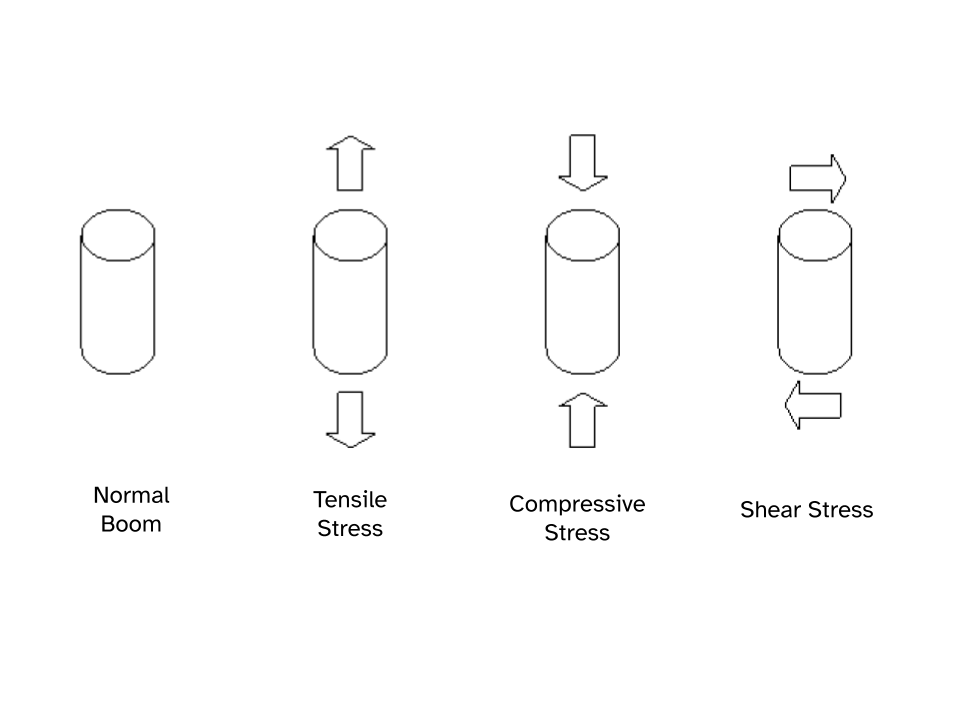
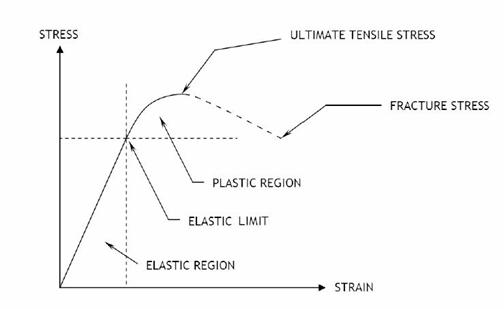

![{\displaystyle Design\ Ratio={\frac {Weight\ Supported}{Boom\ Weight}}\times {\frac {60\left[{\text{s}}\right]}{Anchor\ Time\left[{\text{s}}\right]+30\left[{\text{s}}\right]}}\times {\frac {Boom\ Length\left[{\text{m}}\right]}{1.5\left[{\text{m}}\right]}}\,}](https://wikimedia.org/api/rest_v1/media/math/render/png/813810ebf568ed2a63b9be2be614b546aeff20fa)
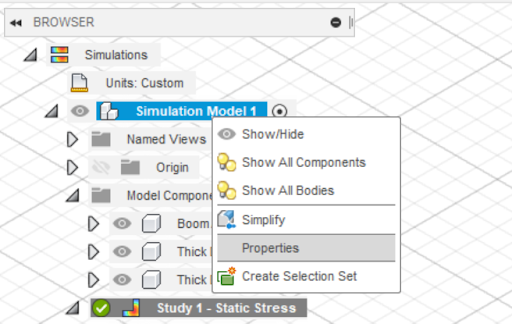
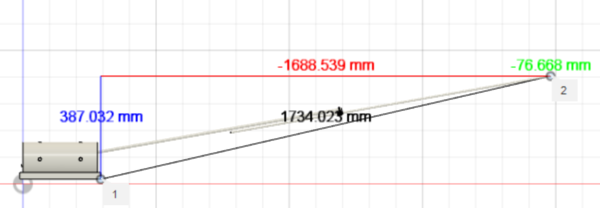

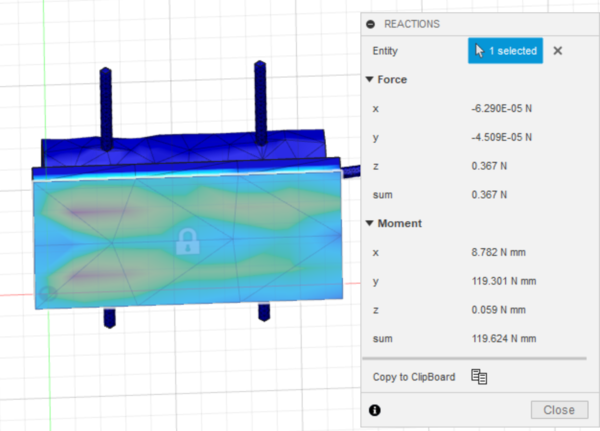
![{\displaystyle Weight\ Supported\left[{\text{kg}}\right]={\frac {Reaction\ Force\left[{\text{N}}\right]}{10\left[{\text{m}}/{s^{2}}\right]}}\,}](https://wikimedia.org/api/rest_v1/media/math/render/png/94d8c1630ee6d8e0590ae87a2202d663f112aa1a)
